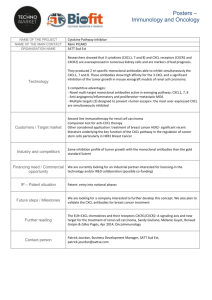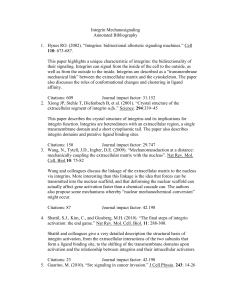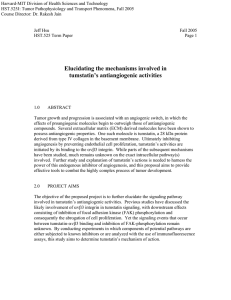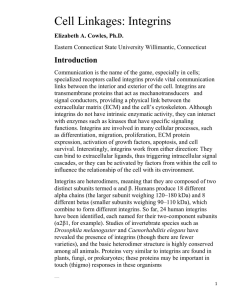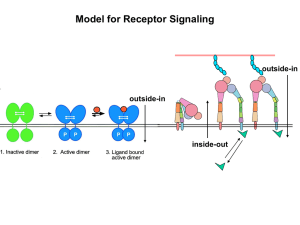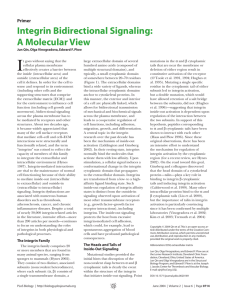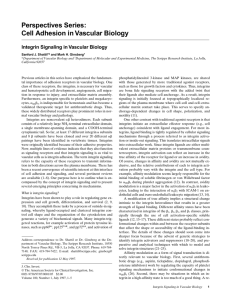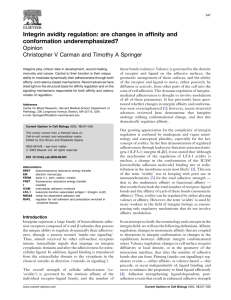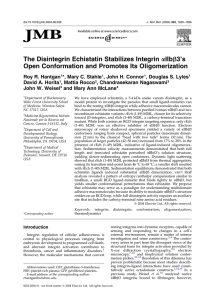jcb_23176_sm_SuppData
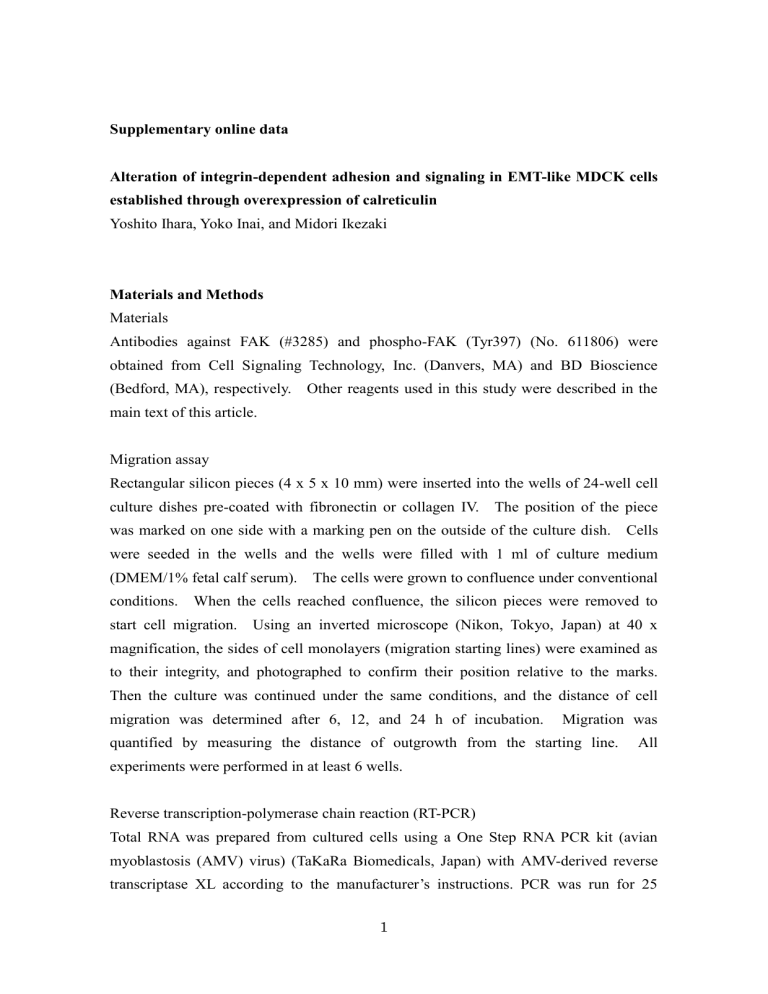
Supplementary online data
Alteration of integrin-dependent adhesion and signaling in EMT-like MDCK cells established through overexpression of calreticulin
Yoshito Ihara, Yoko Inai, and Midori Ikezaki
Materials and Methods
Materials
Antibodies against FAK (#3285) and phospho-FAK (Tyr397) (No. 611806) were obtained from Cell Signaling Technology, Inc. (Danvers, MA) and BD Bioscience
(Bedford, MA), respectively. Other reagents used in this study were described in the main text of this article.
Migration assay
Rectangular silicon pieces (4 x 5 x 10 mm) were inserted into the wells of 24-well cell culture dishes pre-coated with fibronectin or collagen IV. The position of the piece was marked on one side with a marking pen on the outside of the culture dish. Cells were seeded in the wells and the wells were filled with 1 ml of culture medium
(DMEM/1% fetal calf serum). The cells were grown to confluence under conventional conditions. When the cells reached confluence, the silicon pieces were removed to start cell migration. Using an inverted microscope (Nikon, Tokyo, Japan) at 40 x magnification, the sides of cell monolayers (migration starting lines) were examined as to their integrity, and photographed to confirm their position relative to the marks.
Then the culture was continued under the same conditions, and the distance of cell migration was determined after 6, 12, and 24 h of incubation. Migration was quantified by measuring the distance of outgrowth from the starting line. All experiments were performed in at least 6 wells.
Reverse transcription-polymerase chain reaction (RT-PCR)
Total RNA was prepared from cultured cells using a One Step RNA PCR kit (avian myoblastosis (AMV) virus) (TaKaRa Biomedicals, Japan) with AMV-derived reverse transcriptase XL according to the manufacturer’s instructions. PCR was run for 25
1
cycles of 95°C for 0.5 min, 65°C for 0.5 min, and 72°C for 1.5 min. Primers sequences were as follows: for dog integrin
1 (NCBI accession number XM_535143,
261 bp), forward, 5’-AATGTGTTCAGTGCAGAGC-3’, and reverse,
5’-TTGGAATGAT GTCTGGTC-3’; for dog integrin
3 (AF170253, 238 bp), forward,
5’-GATGAGGCCCTGCCTCTGGGCTC-3’, and reverse,
5’-CTTGCCGAACTTGGATGGAGAA-3’; for dog integrin
2 (XM_54326, 783 bp), forward, 5’-CAGGTGACTTTCACTATTAACTT-3’, and reverse,
5’-AGCTAATAGCAAAATTATTC-3’; for dog integrin
5 (XM_543619, 171 bp), forward, 5’-GGCAGCCACGGCGTCCCGCTGTG-3’, and reverse,
5’-GGCATCAGAGGTGGCAGGTGGCTT-3’; for dog integrin
V (XM_545559, 486 bp), forward, 5’-TCTGTTGCTGCCACTGACAT-3’, and reverse,
5’-AACTGGTCTGGCTCTGTATA-3’; for dog glyceraldehyde-3-phospho dehydrogenase (GAPDH) (ML_001003142,
5’-TGAAGGTCGGTGTGAACGGATTTGGC-3’,
5’-CATGTAGGCCATGAGGTCCACCAC-3’.
983 and bp), forward, reverse,
Flow cytometry
Flow cytometric analysis was performed using antibodies against integrins
5,
1, and
V
3. Cells were detached by PBS containing 5 mM EDTA, then fixed with 2% paraformaldehyde at 37°C for 10 min. In the cases with integrins
5 and
1, cells were treated with 90% methanol for 30 min on ice. After blocking with 0.5% BSA in
PBS, cells were incubated with primary antibodies (1:100) at room temperature for 45 min. The cells were labeled with secondary antibodies conjugated with fluorescein
(Cappel Research Products, Organon Teknika Corporation, Durham, NC) or Alexa
Fluor647 (Invitrogen Corporation) at room temperature for 30 min in the dark. The labeled cells were resuspended in PBS, and analyses were performed using FACSAria with BD FACSDiva (BD Bioscience).
Immunoblot analysis
To examine the phosphorylation of proteins induced by cell adhesion to the ECMs, cells were starved overnight in serum-free DMEM, then detached using 0.53 mM EDTA and
0.05% trypsin. Trypsin was inactivated with 0.1% trypsin inhibitor and washed twice with PBS, and resuspended in DMEM/1% BSA. In some experiments, cells were
2
pre-incubated with or without 5
M ionomycin in DMEM/1% BSA at 37°C for 10 min before being seeded. The cells were seeded onto plastic culture plates pre-coated with
ECMs or LCB. After 30 min of incubation at 37°C, the cells were harvested, and protein samples were prepared by lysing the cells with RIPA buffer (20 mM Tris-HCl
[pH7.4], 150 mM NaCl, 2 mM EDTA, 1% Nonidet P-40, 1% sodium deoxycholate, and
0.1% SDS) containing protease inhibitors and protein phosphatase inhibitors (10 mM
NaF, 1 mM sodium vanadate). The detection of phosphorylated proteins was performed by immunoblot analytsis as stated in the main text using specific antibodies.
3
Supplementary data Figure S1.
Fig. S1. The migration of MDCK-Cont and MDCK-CRT1 cells was examined on culture plates pre-coated with collagen IV or fibronectin. Immediately after removal of the silicon piece, the cells form a sharp line from which they start migrating. The cells were cultured for 6, 12, and 24 h, then photographed. Migration was quantified at 24 h by measuring the distance of outgrowth from the starting line. Col IV, collagen
IV; FN, fibronectin. Data are the means ± S.E. for six independent determinations.
4
Supplementary data Figure S2.
Fig. S2. The transcriptional expression of integrins
1,
3,
2,
5, and
V was examined by RT-PCR in control and CRT-overexpressing cells. 1, MDCK; 2,
MDCK-Cont; 3, MDCK-CRT1; 4, MDCK-CRT2. GAPDH, glyceraldehyde-3-phospho dehydrogenase. Data represent three independent experiments.
5
Supplementary data Figure S3.
Fig. S3. The expression of integrins
5,
1, and
V
3 was examined by flow cytometry in control (MDCK-Cont) and CRT-overexpressing MDCK (MDCK-CRT1) cells. (A) The antibodies against integrins
5 and
1. (B) The antibody against integrin
V
3. Gray lines, isotype control IgGs; Black lines, specific IgGs.
6
Supplementary data Figure S4.
Fig. S4. Intracellular localization of FAK in CRT-overexpressing MDCK cells. (A)
The intracellular distribution of FAK (Green) and integrin
1 (Magenta) was evaluated in MDCK-Cont and MDCK-CRT1 cells by immunofluorescence microscopy with specific antibodies (magnification x 400). (B) The intracellular distribution of FAK
(Green) and integrin
V
3 (Magenta) was examined in MDCK-Cont and MDCK-CRT1 cells by immunofluorescence microscopy with specific antibodies. Data represent at least three independent experiments.
7
Supplementary data Figure S5.
Fig. S5. The phosphorylation of FAK (Tyr397) and Akt (Ser473) was examined in control and CRT-overexpressing MDCK cells, when detached cells were seeded on culture plates coated with ECMs. MDCK-Cont and MDCK-CRT1 cells were seeded on culture plates pre-coated with ECMs and incubated for 30 min at 37°C, then harvested and lysed. The phosphorylation of FAK and Akt was examined by immunoblotting with specific antibodies as described in the methods. The expression of FAK and Akt in each sample is also shown. 1, no treatment; 2, collagen IV; 3, fibronectin; 4, LCB. Arrowheads indicate specific bands of proteins detected by the antibodies. Data represent at least three independent experiments.
8
Supplementary data Figure S6.
Fig. S6. Effect of ionomycin on the phosphorylation of Akt (Ser473) was examined in control MDCK cells on attachment to collagen IV. MDCK-Cont cells were detached and treated with or without 5
M ionomycin in DMEM/1% BSA at 37°C for 10 min.
Then the cells were seeded on culture plates pre-coated with collagen IV or LCB and incubated with or without ionomycin for 30 min, then harvested and lysed. The phosphorylation of Akt was examined by immunoblotting with specific antibodies as described in the methods. The expression of Akt in each sample is also shown.
Arrowheads indicate specific bands of proteins detected by the antibodies. Data represent two independent experiments.
9

